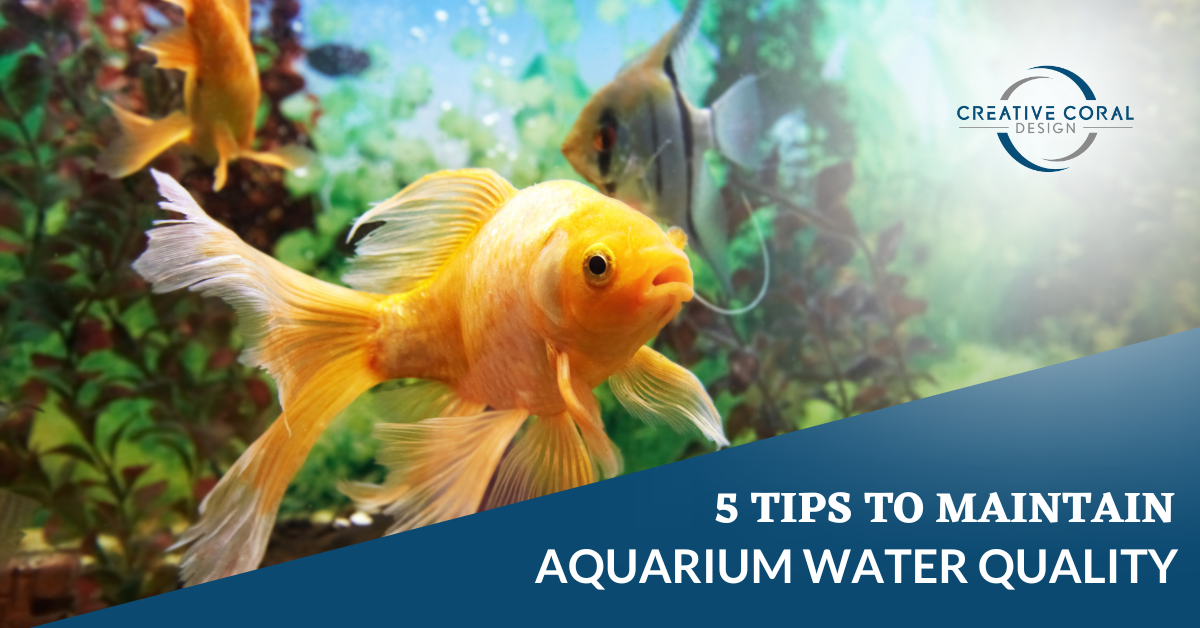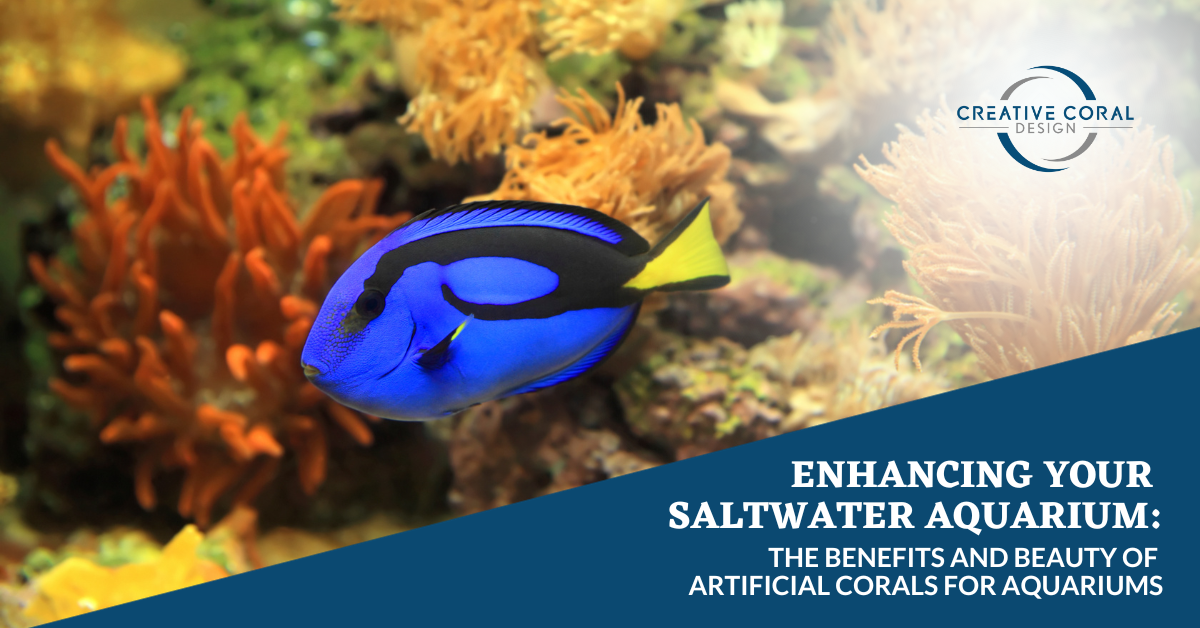Setting up a custom-made aquarium is only half of it; you need proper maintenance to ensure that your fish stay alive. Regular top-ups and water checks are essential to a healthy aquatic environment, where your livestock can thrive.
Things like an erratic cleaning or water-change schedule or having the wrong water balance can lead to a multitude of issues for your fish. Not to mention that neglecting to clean your tank makes it unsightly and unpleasant-smelling.
The good news is, there are accessories and devices to help you maintain an optimal aquarium water quality. Meanwhile, if you’re looking for an easy–to-install, easy-to-maintain habitat for your marine life, we’ll introduce you to modular reef systems. For starters, you can use this blog as a useful aquarium water treatment guide. We’ve also provided insights and helpful tips on aquarium care for beginners, so read on and have fun!
Check out our meticulously handcrafted lifelike artificial corals, grasses, and reef inserts
Table of Contents
Change your water regularly, and be consistent about it.
Many aquarists recommend a weekly water change but others say every other week is fine. The trick is to eyeball your tank, especially in the first few weeks of installation, to check if the water is getting cloudy or murky. For custom-made aquariums, once you’ve settled on a water-change schedule, make sure you stick to it whether it’s weekly or biweekly.
Note though that a water change doesn’t mean replacing all the water in the tank. Emptying just around a third to half of the tank’s volume will do, depending on how dirty the water has gotten. Replacing the old water with clean water controls the build-up of dirt in your tank, keeps in check algae-promoting nutrients like phosphate and nitrate and helps eliminate ammonia and other compounds that are harmful to your fish.
While a water change is good for your aquatic life’s immune system, too much of it can be bad, too. Now you may be thinking, “Why not a monthly full-tank water change and refill, to save on time?” That’s not such a good idea as large water changes will destabilize the aquarium’s chemical balance and stress out your livestock.
See awesome aquarium designs and incredible builds here!
Test your water diligently to make sure it has the right balance.
Both freshwater and saltwater naturally contain microorganisms such as bacteria, cyanobacteria, and protozoa. Good bacteria helps in decomposing organic matter in the aquarium and in promoting the nutrient cycle. They are also important in the food chain, same as true algae and rotifers, which are food sources for fish and invertebrates.
Additionally, cyanobacteria processes naturally occurring or atmospheric nitrogen, detoxifies heavy metals and prevents the growth of pathogens in the tank. There are other types of microorganisms that when totally removed from the aquatic ecosystem can be disastrous. In other words, zero bacteria is not good but we do have to keep them within “healthy” levels.
As a beginner aquarist and owner of a custom-made aquarium, you might find this intimidating but really, all it takes is performing water tests to ensure that your tank has the right balance of bacteria. Luckily for us, there’s a lot of easy-to-use digital water tester kits available in just about any pet store. Testers are also useful when you’re adding new fish to your tank. But the best way to know what you’re checking for is to do your research, especially since the right balance depends on the livestock you have in your tank. Most freshwater aquarium tropical fish require a pH of 6.8 to 7.8 but again, it depends on the specific fish you’re keeping.
Shopping for aquarium livestock? Here are the 10 Most Popular Freshwater Fish for Beginners
Invest in a good filtration system — cutting corners could kill your livestock.
Remember that tap water, no matter how clean it looks, is not suitable as-is — that’s why you need a good filtration system. Tap water in itself may contain trace amounts of heavy metals from your own plumbing system. Also an important aquarium care tip for beginners, you need to treat your tank water with a water conditioner every time you top off.
Additionally, water treatment plants use chemicals that protect the pipes from corrosion. Hard water is not fit for drinking and even more harmful, even fatal, for aquatic life, which are very sensitive to metals. What’s more, hard water has high alkalinity, which can kill live plants in your aquarium.
A reverse osmosis (RO) or reverse osmosis deionization (RODI) filtration system takes care of this problem by removing harmful content from tap water. These water purification systems use a semi-permeable synthetic lining much like a sieve to filter harmful particles, contaminants, and sediments, including chlorine, salt, dirt, and nitrate.
Building a new aquarium? Let our experts help you!
Replace your mechanical, biological, and chemical filters like clockwork.
A good filtration system helps keep the water in your tank at just the right level of pH and alkalinity. These trusty devices are great for when you’re doing water changes, making sure that the water you used to top off your tank has stable chemistry and free of pollutants. But installing a filtration system is pointless if you don’t service your mechanical filters regularly.
The captured particles and organic debris will eventually build up and decay, releasing substances and minerals back into the tank and putting the health of your fish at risk. Mechanical filters are the filter pads, filter socks, and sponges that are in your aquarium filtration systems — the stuff where the unwanted materials accumulate.
On the other hand, chemical filter media such as activated carbon and phosphate remover eliminates harmful substances and organic compounds from the water by setting off chemical reactions. Meanwhile, biological media (biomedia) are essentially housings for bacteria that keeps water safe for your fish. These bacteria colonies that live in biomedia consume substances and chemicals that could harm your livestock.
As a rule of thumb, most aquarists swap out or rinse off their mechanical filters weekly. If you have a filtration system with a reactor or contactor, flush it out every few weeks — don’t wait for it to be completely clogged. Bagged filter media, on the other hand, should be replaced monthly for good measure. As for chemical media and biomedia, the safest way to know when to use these is to ask an experienced aquarist and, yes, do your research.
Here’s why you can trust us to build and design your first aquarium.
Instead of live corals, use eco-friendly and sustainable artificial coral inserts.
A tank with colorful fish and varied livestock is quite a sight in itself. But the plants, rocks, and decorations we put in it adds drama and completes the look. Corals, with their vivid hues and interesting shapes, are a surefire way to level up the aesthetic appeal of your aquarium. They also make your fish happier and healthier by mimicking their natural habitat. However, most aquarists would advise against using real corals for obvious reasons. Artificial coral inserts are an environment-friendly and sustainable option. What’s more, synthetic corals can be used for freshwater and saltwater aquariums alike.
Unlike live coral reefs, man-made coral doesn’t need much maintenance — you don’t have to feed and take care of it like you do your livestock. With live coral, you also need to monitor the water quality in the tank to keep them alive. But with artificial coral, you just take it out of the tank during your regular maintenance and give it a gentle brushing and thorough rinse to remove excess algae or dirt buildup.
What’s more, artificial coral inserts are way more cost-effective than live coral. They are even cheaper than dead coral, which still needs to be harvested from the sea. Plus, you don’t have to wait for artificial coral inserts to grow or acclimatize to the environment, they instantly add zing and style to your tank. Perhaps the best thing about man-made corals is you can customize them according to the theme of your aquarium.
Setting up a freshwater aquarium? Here are 7 things you should know
At Creative Coral Design, we produce meticulously crafted artificial coral inserts with unrivaled detail to make them look like the real thing. We can give you the beautiful look of natural coral without limiting your fish selection or taking the time needed to maintain a live coral reef. Our artificial coral and reef inserts are molded from real coral skeletons and individually hand-trimmed for incredible detail and realistic appearances. They’re also available in a wide variety of sizes, colors, and styles, offering you endless possibilities to customize the look of your aquarium.
What’s more, the modular design of our artificial reef systems makes it absolutely hassle-free to build an amazing habitat for your marine life. It also allows you to update, modify, and expand your aquarium decorations instantly! Recreate the beauty of natural fresh and saltwater environments with our meticulously handcrafted lifelike artificial corals, grasses, and reef inserts. We use real coral skeletons to create our molds, then hand-trim each piece for incredible realism and function. All of our products are durable, low-maintenance, non-toxic, safe for marine life, and proudly made in the USA.
And if it has always been your dream to have your own aquarium, whether for home or commercial use, we can help you make it happen. Creative Coral Design believes that beautiful and functional aquariums should be accessible to all. That’s why we offer premium, exhibit-level products and services at not-so-premium prices. We can bring your aquarium project to life — to the limits of your imagination!
Have big ideas for your home or office aquarium? Let us help you turn them into a reality.










[…] 5 Tips To Maintain Aquarium Water Quality […]
[…] 5 Tips To Maintain Aquarium Water Quality […]
[…] 5 Tips To Maintain Aquarium Water Quality […]
[…] 5 Tips To Maintain Aquarium Water Quality […]